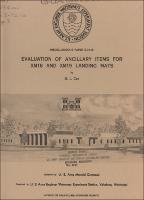Please use this identifier to cite or link to this item:
https://hdl.handle.net/11681/20868Full metadata record
| DC Field | Value | Language |
|---|---|---|
| dc.contributor | United States. Army Materiel Command | - |
| dc.contributor.author | Carr, Gordon L. | - |
| dc.date.accessioned | 2017-01-17T21:35:12Z | - |
| dc.date.available | 2017-01-17T21:35:12Z | - |
| dc.date.issued | 1972-05 | - |
| dc.identifier.uri | http://hdl.handle.net/11681/20868 | - |
| dc.description | Miscellaneous Paper | - |
| dc.description | Abstract: This report describes an investigation conducted to evaluate experimental quantities of ancillary items for use with XM18 and XM19 landing mats. Traffic and field tests were conducted to obtain information for use in comparing the performance life of the ancillary items with the performance life requirement for landing mat. The items investigated were: turn adapters (female/underlap, male/overlap, and male/underlap), access adapters, starting connectors, half panels, repair panels, closure panels, edge anchors, anchor attachments, and turndown adapters. Engineer design tests were conducted on a prepared subgrade, with a rolling wheel load simulating actual aircraft operations. These tests were conducted with a single-wheel load of 25,000 lb with a tire inflation pressure of 250 psi on mat-surfaced subgrades. The field tests were performed at Dyess AFB, Texas, with C-130, F-4B, F-4C, C-141, and other lighter aircraft. Results of this investigation and of related referenced investigations revealed that: (A.) The turn adapters, access adapters, starting connectors, and half panels withstood 1100 coverages of the required load on a 4-CBR subgrade. The female/overlap adapter, similar in design to the female/underlap adapter, was not tested, but it is believed that its performance under traffic would be similar to that of the female/underlap adapter. (B.) The initial repair panels sustained a maximum of 152 coverages on a 4-CBR subgrade. Failures occurred along the diagonal overlap connectors. A revised repair panel, fabricated after initial panels had been made and the production line further refined and adjusted, sustained over twice (340) the number of coverages sustained during the first test on a 4-CBR subgrade, although failure occurred in the same manner. (C.) The closure panels sustained only 50 coverages of traffic on a 4-CBR subgrade. All panels were deformed and had weld failures. (D.) The anchors, though difficult to auger into the soil, proved successful in the field tests. Modified anchor attachments will prevent disengagement of the anchors and attachment(s) (as was experienced with the initial attachments in the field tests). It is recommended that: (1.) The turn adapters, access adapters, starting connectors, and half panels (with minor changes as discussed herein) be accepted as standard items. (2.) The XM19 repair panel design be studied and improvements be made to increase the service life of the item. (3.) The requirement for a closure panel be studied as to its practicability in regard to design, cost, and need in field construction. (4.) The edge anchor and modified anchor attachments be accepted as standard items. NOTE: This file is large. Allow your browser several minutes to download the file. | - |
| dc.publisher | U.S. Army Engineer Waterways Experiment Station. | - |
| dc.publisher | Engineer Research and Development Center (U.S.) | - |
| dc.relation | http://acwc.sdp.sirsi.net/client/en_US/search/asset/1048046 | - |
| dc.rights | Approved for public release; distribution is unlimited. | - |
| dc.source | This Digital Resource was created from scans of the Print Resource | - |
| dc.subject | Landing mats | - |
| dc.subject | XM18 landing mat | - |
| dc.subject | XM19 landing mat | - |
| dc.subject | Subgrades | - |
| dc.subject | Trafficability | - |
| dc.subject | Evaluation | - |
| dc.title | Evaluation of ancillary items for XM18 and XM19 landing mats | - |
| dc.type | Report | en_US |
| Appears in Collections: | Miscellaneous Paper | |
Files in This Item:
| File | Description | Size | Format | |
|---|---|---|---|---|
| MP-S-72-16.pdf | 32.49 MB | Adobe PDF |  View/Open |